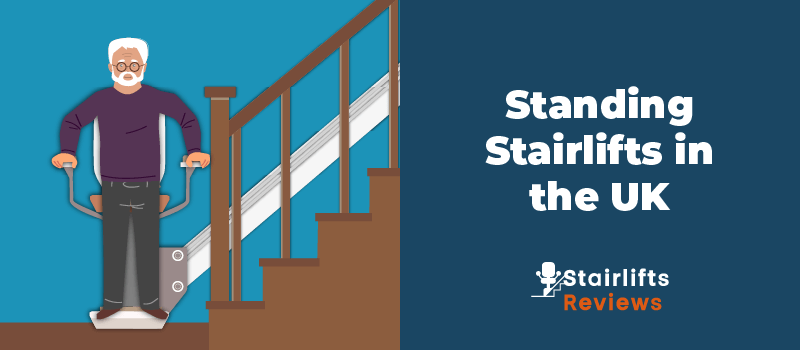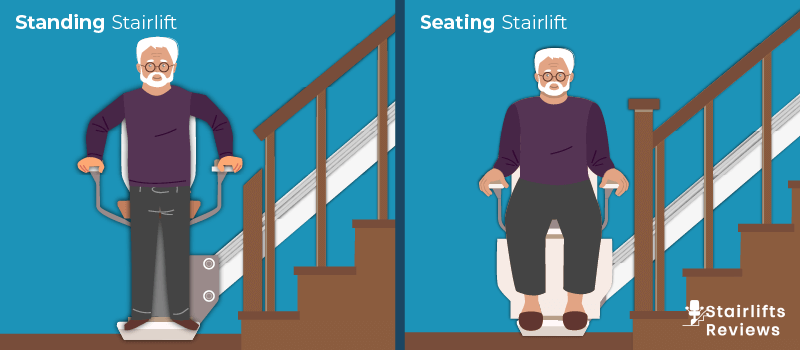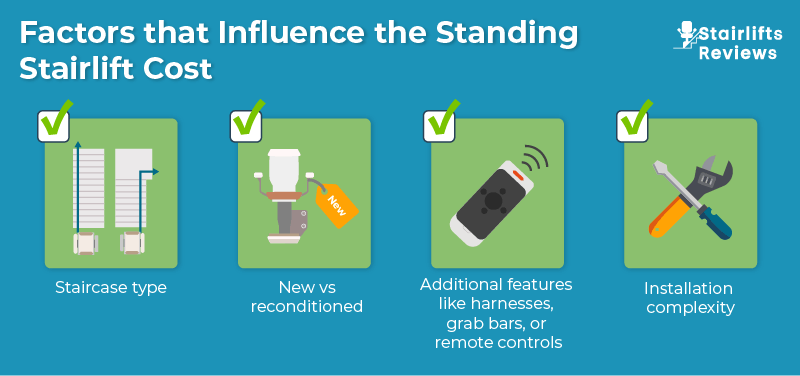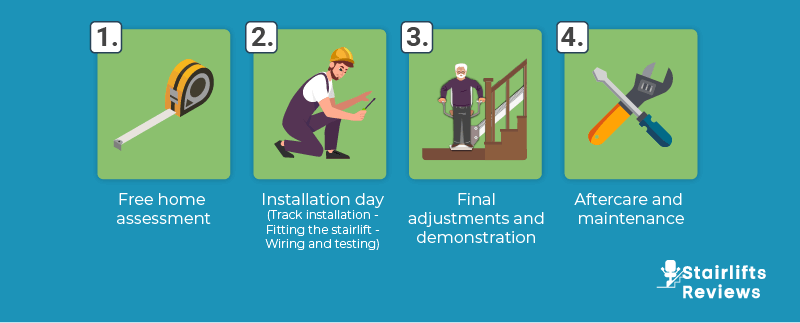

Do you or your loved one struggle bending your knees or navigating the stairs? Then a standing stairlift will resolve this issue as it lets you remain upright when moving between the levels of your home. The standing stairlift will let you remain upright while navigating stairs. The perch seat will even carry most of the weight, so your joints won’t suffer any further weight.
In this guide, you will learn if a standing stairlift is the right solution for you. The cost of this type of stairlift. We will also cover what you can expect from the installation process and how long it takes.
If you already know that a standing stairlift is the right thing for you, we can help you find the right installer. We have a network of trusted installers ready to help you. All you have to do is fill in our short form, and you will receive up to 4 quotes on a standing stairlift to your home.
Using our service will help you save hours on research, and comparing quotes will save you money.
Click the button below to begin!
What are standing stairlifts?
Standing stairlift prices in the UK
Which brands manufacture standing stairlifts in the UK?
Pros and cons of standing platform stairlifts
Stand-on stairlift installation
Is a standing stairlift the right choice for you?
FAQ
Standing stairlifts consist of a smaller platform, an armrest and a high, angled perch seat that supports the user while standing upright. The perch seat takes most of the user’s weight, so the user will still not strain their knees or hips.
Compared to a regular stairlift that includes a full seat, backrest, and footrest, which gives the user a traditional seated experience. A standing stairlift gives the user the flexibility to be upright when transported between the floors of the house.
 A standing stairlift can be beneficial if you have a narrow staircase (less than 75 cm (30 inches) wide), where a regular seated stairlift won’t fit.
A standing stairlift can be beneficial if you have a narrow staircase (less than 75 cm (30 inches) wide), where a regular seated stairlift won’t fit.
A standing stairlift can be beneficial for multiple types of users. But it is especially beneficial for people who:
If you struggle with balance while upright or have severe mobility issues, you will not benefit from a standing stairlift. In these situations, the best type of stairlift will be a standard seated one.
The cost of a standing stairlift can range from £700 to £7,000. The stairlift cost depends on the type of stairlift (curved stairlifts are more expensive) and whether it is a new or a reconditioned stairlift.
To get the best stairlifts for your home, it’s important to compare multiple options. The prices can vary, but finding the right model for your needs will ensure you get the best value for your investment.
| Standing stairlift price | |
|---|---|
| Type of standing stairlift | Price (incl. installation) |
| New straight standing stairlift | £1,800 – £4,000 |
| New curved standing stairlift | £3,750 – £7,000 |
| Reconditioned straight standing stairlift | £700 – £2,395 |
| Reconditioned curved standing stairlift | £2,500 – £4,000+ |
Reconditioned straight stairlifts have the lowest price point, but are not always the right option for everybody.
For most stairlifts, you have the option of renting. The price of renting a standing stairlift is from £10 weekly, depending on the provider.
When you have your standing stairlift installed, you can expect the running costs to be around £10-£20 per year. Running costs depend on current electricity prices, but even with high electricity prices, the yearly running costs should not exceed £20.
The final price of a standing stairlift depends on many different factors, some of which are not something you can change.

The type of staircase you have will affect the price of your stairlift. A curved stairlift is a more complex installation and will be more costly.
In the UK, there are a number of grants that can lower the cost of a stairlift if you are eligible. The Disabled Facilities Grant (DFG) covers free stairlifts for pensioners in the UK.
To get the best price, you should always compare multiple quotes. Save hours of research by letting us do the work for you. Answer a few simple questions, and you’ll receive up to 4 free stairlift quotes from installers near you.
In the UK, there are a number of brands that manufacture stairlifts. Among the brands are: Handicare stairlifts, Acorn stairlifts and Age UK stairlifts.
All three brands have standing stairlift models as part of their catalogue. In the table, you can find information about the three brands standing stairlift models.
| Standing stairlift brands in the UK | ||||
|---|---|---|---|---|
| Brand | Model name | Stair type | Price | Warranty |
| Acorn | Sit/Stand | Straight | £2,195 | 12 months (additional cover up to 4 years) |
| Handicare | 1000 Perch | Straight | £2,995 | 2 years |
| Handicare | 4000 Curved with Perch Seat | Curved | £5,365 | 2 years |
| Age Co | 4000 Curved | Curved | £4,500 – £8,000 | 2 years |
Prices are only an estimate; for actual prices, contact installers who can provide you with quotes.
All of the above-mentioned brands also manufacture other types of stairlifts like outdoor stairlifts, mobile stairlifts and wheelchair stairlifts.
| Pros and cons of standing stairlifts | |
|---|---|
| Pros | Cons |
| Space-saving design | Requires balance |
| Faster installation | Limited comfort |
| Versatile use | Not suitable for everyone |
| Reduced strain | Limited customisation |
Like most things, a standing stairlift comes with both pros and cons. For most people, the pros outweigh the cons. To be most prepared as a potential user, it is important to acknowledge the cons as well as the pros.
Space-saving design: A standing stairlift is more slim than a regular seated stailift, this makes it possible for the stairlift to fit into even narrow staircases.
Faster installation: With the compact and straightforward design, a standing stairlift is typically quicker to install. The installation time is typically between 2–4 hours.
Versatile use: A standing stairlift is suitable for users who prefer standing or leaning rather than sitting. With the perch seat, the weight of the user is still supported so the knees and hips are not strained.
Reduced strain: For people with joint or back pain, a standing stairlift will minimise the need to sit or stand fully. Avoiding the use of stairs completely can reduce the strain on the knees
Requires balance: While the armrest and the perch seat will support the user, you will still need to balance yourself during transportation. People with severe balance issues should avoid using a standing stairlift.
Limited comfort: If the staircases are longer, the prolonged standing can become uncomfortable. As a standing stairlift is a small one, the space on the lift itself is limited.
Not suitable for everyone: While a stairlift can be good for most people, a standing model should not be used by people with conditions that affect coordination, strength, and balance. Standing stairlifts often have a weight limitation, supporting up to 120-140kg (18-22 stone)
Limited customisation: A standing stairlift is less adjustable than a seated stairlift. This can limit the possibilities of adjusting it exactly to your needs and impact comfort. The only thing that can be adjusted is the perch seat, but with limitations.
The installation process of a standing stairlift consists of a 5-step process, and is fairly straightforward. With a professional installer, you can expect the stairlift installation time to be around 2–4 hours and should not cause any bigger disruptions to your day.

Step 1: Free home assessment
In the free home assessment, a stairlift provider will visit your home and assess your staircase layout. You will together discuss your mobility needs and how the stairlift will be used.
The surveyor will take precise measurements and give you advice on the best stairlift for your home. At the end of the assessment, you will receive a detailed quote with the suggested stairlift model and any custom features needed.
Step 2: Installation day
On installation day, a professional installer will come and fit your new stairlift in your home. The actual installation is three small steps:
Step 3: Final adjustments and demonstration
After installation, the installer will make any adjustments to fit the stairlift to your needs, whether it be adjustments to the unit or the speed of the stairlift. They will then provide a full demonstration on how to use the stairlift, making sure you know the basic operation and the safety features.
Step 4: Aftercare and maintenance
Many stairlift providers offer aftercare and maintenance packages. To make sure your stairlift runs smoothly, regular servicing is important as it will further extend its lifespan. Discuss the possibility of service plans and maintenance options with your installer.
We always recommend having a professional installer install your stairlift. With a professional installer, you can be sure that the installation will be correct, and if anything happens, a warranty will typically cover the repairs. If you want to apply for a grant to cover some of the costs, a professional installer is typically required.
Are your knees easily overstrained when you use stairs or when you bend them too much? This should not limit your mobility at home! A standing stairlift can help resolve some of these problems.
A standing stairlift will let you navigate all the floors in your house without any discomfort in your knees. The perch seat on the stairlift will take all the weight, so you can stand comfortably on the platform. A standing stairlift can fit into most staircases as it has a slim design, so even a narrow staircase won’t be an issue.
If you’re looking for a stairlift in the UK, a standing stairlift might be a practical option, offering flexibility without sacrificing comfort.
When getting a standing stairlift, you should always get multiple quotes that you can compare and ensure you will get the best price without overpaying for the service. We can help you find the quotes so you both save time and money.
Answer a few questions, and you will receive up to 4 quotes from professional installers in our network.
Is there a stairlift you can stand on?
Yes, with standing stairlifts you can stand while navigating between the floors in your home. These types of stairlifts typically have a perch seat that will take most of the weight.
How much does a standing stairlift cost in the UK?
The cost of a standing stairlift ranges from £700 to £7,000 depending on the type of staircase and the type of stairlift, if it is new or reconditioned.
Are there stand-on stairlifts that do not require installation?
Unfortunately, there are no stand on mobile stairlifts. All standing stairlifts will have to be mounted on the steps of the staircase.

Swathi Subhash Nair is a skilled content writer with a background in journalism and a strong interest in home upgrades and smart solutions. With years of experience in writing engaging, informative pieces, she combines her passion for storytelling with an acute attention to detail to deliver high-quality content for Stairlift Reviews.
View all postsThis site uses cookies. By continuing to browse the site you are agreeing to our use of cookies. Find out more here [X]

